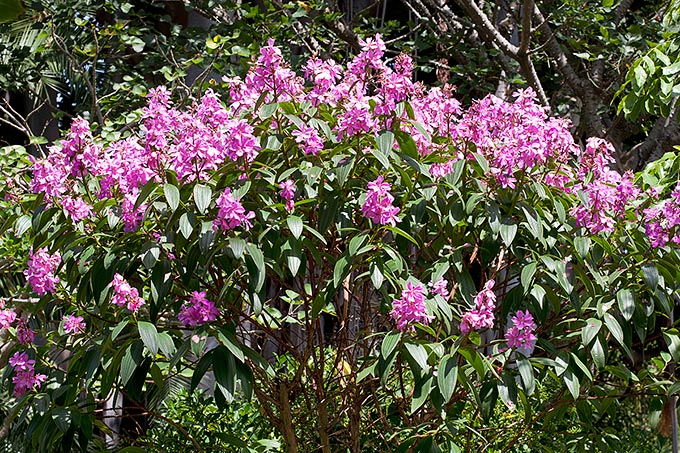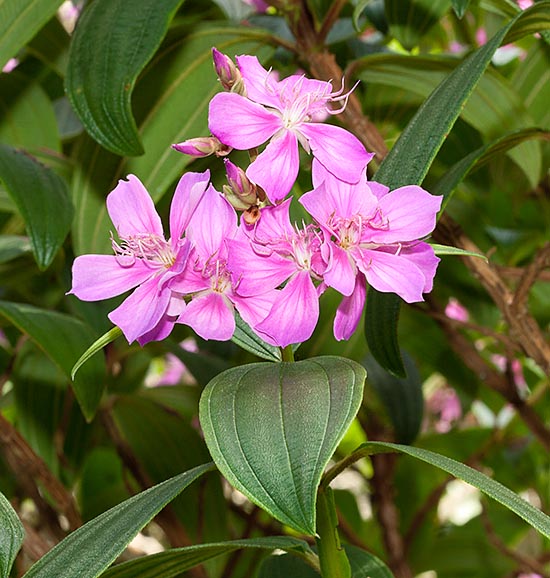Family : Melastomataceae

Text © Pietro Puccio

English translation by Mario Beltramini

Tibouchina granulosa is a 2-12 m tall evergreen small tree with 20-24 cm trunks © Giuseppe Mazza
The name of the genus is the one used in Guyana; the name of the species is the Latin adjective “granulosus, a,um” = lumpy, wrinkly, with reference to the surface of the leaf.
Common names: Brazilian glory tree, glory bush tree, glory tree, purple glory tree, purple spray tree (English); flor de quaresma, quaresma de folha grande, quaresmeira, quaresmeira roxa (Portuguese-Brazil).
The Tibouchina granulosa (Desr.) Cogn. (1885) is a shrub or a 2-12 m tall evergreen tree with trunk of 20-40 cm of diameter and quadrangular section shaggy young branches with winged edges.
The leaves, on a 1-3 cm long petiole, are simple, opposite and decussate (each pair is rotated by a right angle in respect to the previous one), ovate-lanceolate with entire margin and pointed apex, 5-18 cm long and 3-6 cm broad, coriaceous, of glossy intense green colour on the upper page with short whitish hairs which grant a wrinkly look, pale green and pubescent below, grooved by 5 marked longitudinal nervations.

The violet purple inflorescences reach even 30 cm © Giuseppe Mazza
The fruits are ovoid pubescent capsules, of about 1 cm of length and 0,6 cm of diameter, containing several brown, 1 mm long, seeds. It reproduces by seed placed superficially on sandy loam kept humid at the temperature of 22-24 °C, with 3-6 weeks germination times, and by apical cutting, after the flowering, in confined air.
Considered as one of the most ornamental species of the tropical flora for the foliage as well as for the abundant and long-lasting flowering, repeating 2-3 times per year from spring to late autumn, it is cultivable in the tropical and subtropical climate zones, its cultivation may be tried marginally in the warm temperate ones where minimum temperatures just under the 0 °C are short-lasting exceptions.
It is to be placed in full sun or filtered sunlight and sheltered from the strong winds, being the branches rather frail, on well drained acidic or neutral soils, ideal are the sandy ones rich of organic substance; it requires regular waterings, but leaving the soil to dry up partially before giving water again, and fertilizations, using specific products for acidophilic plants. It can be grown as bush, even low, as well as tree, as it well bears the prunings, even if drastic, which favour its tillering, to be done after the flowering; utilizable as isolated specimen, in group, for borders and hedges in parks and gardens, even if small, or as road tree. Where the climate does not allow its permanence in open air for the whole year, it can be cultivated in pot, as it blooms also when its dimensions are contained, in order to be sheltered during the colder months in a very luminous location with lowest temperatures not under the 12 °C.
Synonyms: Melastoma granulosum Desr. (1797).
→ To appreciate the biodiversity within MELASTOMATACEAE family please click here.
